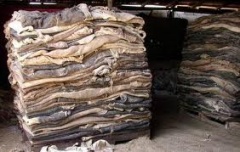Difference between revisions of "Hides and skins"
| Line 7: | Line 7: | ||
| risk factors = Heating, wetting, mechanical influence (contact with metal) decomposition due to bacterial action | | risk factors = Heating, wetting, mechanical influence (contact with metal) decomposition due to bacterial action | ||
}} | }} | ||
| + | ==Description== | ||
| + | A hide is an animal skin treated for human use. Hides include [[leather]] from cattle and other livestock [[animals]], alligator skins, [[snake skins]] for shoes and fashion accessories and furs from wild cats, mink and bears. In some areas, [[leather]] is produced on a domestic or small industrial scale, but most leather making is done on a large scale. Various tannins are used for this purpose. | ||
| + | Animal hides are stretched, dried and tanned. It is more cost-effective today to raise [[animals]] in captivity and then kill them. Large farms exist to raise mink and rabbit for fur while much fox, lynx, wolf and other animals are trapped for fur. | ||
Revision as of 08:42, 26 July 2012
| Infobox on Hides and skins | |
|---|---|
| Example of Hides and skins |  |
| Facts | |
| Origin | All continents |
| Stowage factor (in m3/t) |
|
| Humidity / moisture | - |
| Ventilation | Adequate circulation of air |
| Risk factors | Heating, wetting, mechanical influence (contact with metal) decomposition due to bacterial action |
Hides and skins
Contents
Description
A hide is an animal skin treated for human use. Hides include leather from cattle and other livestock animals, alligator skins, snake skins for shoes and fashion accessories and furs from wild cats, mink and bears. In some areas, leather is produced on a domestic or small industrial scale, but most leather making is done on a large scale. Various tannins are used for this purpose. Animal hides are stretched, dried and tanned. It is more cost-effective today to raise animals in captivity and then kill them. Large farms exist to raise mink and rabbit for fur while much fox, lynx, wolf and other animals are trapped for fur.











